Attractions
List of attractions
Viale dei Gladiatori, 00135 Roma RM, Italy
Stadio Olimpico
The Stadio Olimpico is the main and largest sports facility of Rome, Italy. It is located within the Foro Italico sports complex, north of the city. The structure is an asset of the Italian National Olympic Committee and it is intended primarily for football. The Stadio Olimpico is the home stadium of Serie A clubs Lazio and Roma and also hosts the Coppa Italia final. It was rebuilt for the 1990 FIFA World Cup and it hosted the tournament final. Rated an UEFA category four stadium, it has also hosted four European Cup finals, the most recent being the 2009 UEFA Champions League Final. Outside football, the stadium is used by the Italian national rugby union team and it is Italy's national athletics stadium. Occasionally, it hosts concerts and events.
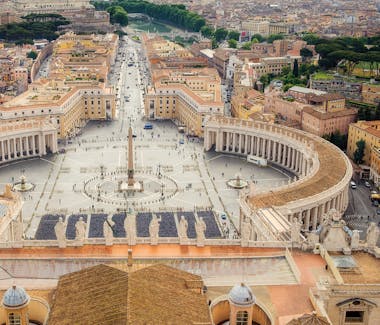
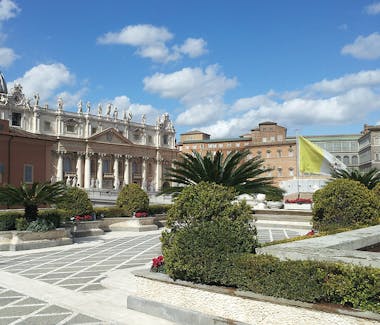
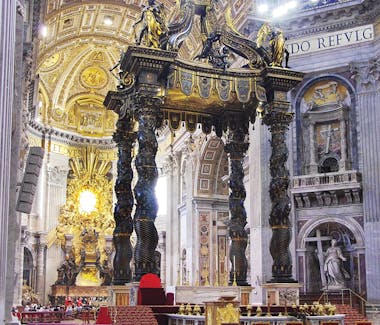

00120, Vatican City
Vatican City
Vatican City; Italian: Citt�� del Vaticano; officially Vatican City State or State of Vatican City Italian: Stato della Citt�� del Vaticano; is an independent state located within the city of Rome. With an area of 44 hectares (110 acres), and a population of about 1,000, it is the smallest state in the world by both area and population. However, formally it is not sovereign, with sovereignty being held by the Holy See. It is an ecclesiastica or sacerdotal-monarchica state (a type of theocracy) ruled by the Bishop of Rome ��� the Pope. The highest state functionaries are all Catholic clergy of various national origins. Since the return of the popes from Avignon in 1377, they have generally resided at the Apostolic Palace within what is now Vatican City, although at times residing instead in the Quirinal Palace in Rome or elsewhere. Vatican City is distinct from the Holy See, which dates back to early Christianity and is the main episcopal see of 1.2 billion Latin and Eastern Catholic adherents around the globe. The independent city-state, on the other hand, came into existence in 1929 by the Lateran Treaty between the Holy See and Italy, which spoke of it as a new creation, not as a vestige of the much larger Papal States (756���1870), which had previously encompassed much of central Italy. According to the terms of the treaty, the Holy See has "full ownership, exclusive dominion, and sovereign authority and jurisdiction" over the city-state.
Via Salaria, 430, 00199 Roma RM, Italy
Catacombs of Priscilla
View On MapLa Rinascente Roma - 1st floor - via Aniene 1, 00189 Rome RM, Italy
Fay
View On MapPiazzale Napoleone 1, 00197 Roma RM, Italy
Villa Borghese gardens
Villa Borghese is a landscape garden in the naturalistic English manner in Rome, containing a number of buildings, museums and attractions. It is the third largest public park in Rome (80 hectares or 197.7 acres) after the ones of the Villa Doria Pamphili and Villa Ada. The gardens were developed for the Villa Borghese Pinciana ("Borghese villa on the Pincian Hill"), built by the architect Flaminio Ponzio, developing sketches by Scipione Borghese, who used it as a villa suburbana, a party villa, at the edge of Rome, and to house his art collection. The gardens as they are now were remade in the early nineteenth century.
00120, Vatican City
The Sistine Chapel
The Sistine Chapel is a chapel in the Apostolic Palace, the official residence of the Pope, in Vatican City. Originally known as the Cappella Magna, the chapel takes its name from Pope Sixtus IV, who restored it between 1477 and 1480. Since that time, the chapel has served as a place of both religious and functionary papal activity. Today it is the site of the Papal conclave, the process by which a new pope is selected. The fame of the Sistine Chapel lies mainly in the frescos that decorate the interior, and most particularly the Sistine Chapel ceiling and The Last Judgment by Michelangelo.
Via Salaria, 265, 00199 Roma RM, Italy
Villa Ada
Villa Ada is a park in Rome, Italy, with a surface of 450 acres (1.8 km2) it is the second largest in the city after Villa Doria Pamphili. It is located in the northeastern part of the city.
Piazzale Scipione Borghese, 5, 00197 Roma RM, Italy
Borghese Gallery and Museum
Lorem ipsum dolor sit amet, consectetur adipiscing elit. Cras in orci diam. Quisque malesuada sodales faucibus. Fusce aliquet tellus sit amet ullamcorper vehicula. Duis lacinia velit vitae molestie porttitor. Fusce interdum odio leo, vel sodales nibh dapibus vestibulum. Quisque eu nisi vitae tellus commodo eleifend vitae sed justo. Morbi leo dolor, commodo a lectus quis, egestas vulputate metus.
Website: www.galleriaborghese.it
Piazza del Campidoglio, 1, 00186 Roma RM, Italy
Capitoline Museums
The Capitoline Museums (Italian: Musei Capitolini) are a single museum containing a group of art and archaeological museums in Piazza del Campidoglio, on top of the Capitoline Hill in Rome, Italy. The historic seats of the museums are Palazzo dei Conservatori and Palazzo Nuovo, facing on the central trapezoidal piazza in a plan conceived by Michelangelo in 1536 and executed over a period of more than 400 years. The history of the museums can be traced to 1471, when Pope Sixtus IV donated a collection of important ancient bronzes to the people of Rome and located them on the Capitoline Hill. Since then, the museums' collection has grown to include a large number of ancient Roman statues, inscriptions, and other artifacts; a collection of medieval and Renaissance art; and collections of jewels, coins, and other items. The museums are owned and operated by the municipality of Rome.
Arco della Pace, 5, 00186 Roma RM, Italy
Cloister of Bramante
Lorem ipsum dolor sit amet, consectetur adipiscing elit. Cras in orci diam. Quisque malesuada sodales faucibus. Fusce aliquet tellus sit amet ullamcorper vehicula. Duis lacinia velit vitae molestie porttitor. Fusce interdum odio leo. Lorem ipsum dolor sit amet, consectetur adipiscing elit. Cras in orci diam malesuada sodales faucibus.
Website: www.chiostrodelbramante.it
Via della Pilotta, 17, 00187 Roma RM, Italy
Palazzo Colonna
Lorem ipsum dolor sit amet, consectetur adipiscing elit. Cras in orci diam. Quisque malesuada sodales faucibus. Fusce aliquet tellus sit amet ullamcorper vehicula. Duis lacinia velit vitae molestie porttitor. Fusce interdum odio leo, vel sodales nibh dapibus vestibulum. Quisque eu nisi vitae tellus commodo eleifend vitae sed justo. Morbi leo dolor, commodo a lectus quis, egestas vulputate metus.
Website: www.galleriaborghese.it
Via dei Robilant, 1, 00135 Roma RM
Stadio dei Marmi
The Stadio dei Marmi (Italian: "Stadium of the Marbles") is a sport stadium in the Foro Italico, a sport complex in Rome, Italy. It was designed in the 1920s as a complement to the annexed Academy of Physical Education (now the seat of CONI, Italian Olympic Committee), to be used by its students for training. Originally designed by Enrico Del Debbio, construction was completed in 1928. It has Carrara marble steps lined by 59 (60 in the original project) marble statues in classical style portraying athletes that perform various sporting disciplines. Each statue was offered by the provinces of Italy. The stadium was inaugurated in 1932. It hosted some of the field hockey preliminaries for the 1960 Summer Olympics. Stadio dei Marmi was also the host for the 2009 World Aquatics Championships opening ceremony.
Via Pietro de Coubertin, 30, 00196 Roma RM
Parco della Musica
Parco della Musica is a large public music complex in Rome, Italy, with three indoor concert halls and an outdoor theater in a park setting, hence its name.
Ponte Milvio, 00196 Roma RM
Ponte Milvio
The Milvian (or Mulvian) Bridge is a bridge over the Tiber in northern Rome. It was an economically and strategically important bridge in the era of the Roman Empire and was the site of the famous Battle of the Milvian Bridge.



Piazza della Rotonda, 00186 Roma RM, Italy
Pantheon
The Pantheon is a former Roman temple, now a church, in Rome, Italy, on the site of an earlier temple commissioned by Marcus Agrippa during the reign of Augustus (27 BC ��� 14 AD). The present building was completed by the emperor Hadrian and probably dedicated about 126 AD. He retained Agrippa's original inscription, which has caused confusion over its date of construction as the original Pantheon burned down, so it is not certain when the present one was built.





Piazza Venezia, 00186 Roma RM
Piazza Venezia
Piazza Venezia is the central hub of Rome, Italy, in which several thoroughfares intersect, including the Via dei Fori Imperiali and the Via del Corso. It takes its name from the Palazzo Venezia, built by the Venetian Cardinal, Pietro Barbo (later Pope Paul II) alongside the church of Saint Mark, the patron saint of Venice. The Palazzo Venezia served as the embassy of the Republic of Venice in Rome. One side of the Piazza is the site of Italy's Tomb of the Unknown Soldier in the Altare della Patria, part of the Monument to Vittorio Emanuele II, first king of Italy. The piazza or square is at the foot of the Capitoline Hill and next to Trajan's Forum. The main artery, the Via di Fori Imperiali begins there and leads past the Roman Forum to the Colosseum. Capitalizing on this modern and ancient symbolism--and the useful open space--Piazza Venezia was the location of public speeches given by the Italian dictator Mussolini to crowds of his supporters in the 1920s-1940s. In 2009, during excavations in the middle of the square for the construction of the Rome C Metro Line, remains of the emperor Hadrian's Athenaeum were unearthed.
Via della Salara Vecchia, 5/6, 00186 Roma RM
Foro Romano
Lorem ipsum dolor sit amet, consectetur adipiscing elit. Cras in orci diam. Quisque malesuada sodales faucibus. Fusce aliquet tellus sit amet ullamcorper vehicula. Duis lacinia velit vitae molestie porttitor. Fusce interdum odio leo. Lorem ipsum dolor sit amet, consectetur adipiscing elit. Cras in orci diam malesuada sodales faucibus .




Piazza Navona, 00186 Roma RM
Piazza Navona
Piazza Navona is a square in Rome. It is built on the site of the Stadium of Domitian, built in the 1st century AD, and follows the form of the open space of the stadium The ancient Romans went there to watch the agones ("games"), and hence it was known as "Circus Agonalis" ("competition arena"). It is believed that over time the name changed to in avone to navone and eventually to navona.

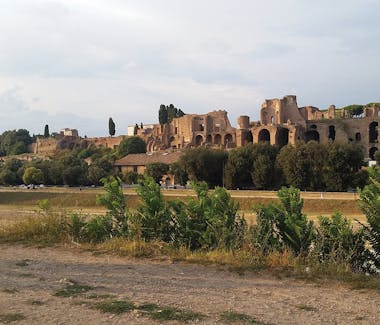
Via del Circo Massimo, 00186 Roma RM, Italy
The Circus Maximus
The Circus Maximus is an ancient Roman chariot-racing stadium and mass entertainment venue located in Rome, Italy. Situated in the valley between the Aventine and Palatine Hills, it was the first and largest stadium in ancient Rome and its later Empire. It measured 621 m (2,037 ft) in length and 118 m (387 ft) in width and could accommodate over 150,000 spectators. In its fully developed form, it became the model for circuses throughout the Roman Empire. The site is now a public park.
Piazza della Bocca della Verit��, 18, 00186 Roma RM
The Mouth of Truth
The Mouth of Truth is a marble mask in Rome, Italy, which stands against the left wall of the portico of the Santa Maria in Cosmedin church, at the Piazza della Bocca della Verit��, the site of the ancient Forum Boarium (the ancient cattle market). It attracts visitors who audaciously stick their hand in the mouth.



Piazza del Popolo, 00187 Roma RM
Piazza del popolo
Piazza del Popolo is a large urban square in Rome. The name in modern Italian literally means "People's Square", but historically it derives from the poplars after which the church of Santa Maria del Popolo, in the northeast corner of the piazza, takes its name. The piazza lies inside the northern gate in the Aurelian Walls, once the Porta Flaminia of ancient Rome, and now called the Porta del Popolo. This was the starting point of the Via Flaminia, the road to Ariminum (modern-day Rimini) and the most important route to the north. At the same time, before the age of railroads, it was the traveller's first view of Rome upon arrival. For centuries, the Piazza del Popolo was a place for public executions, the last of which took place in 1826.
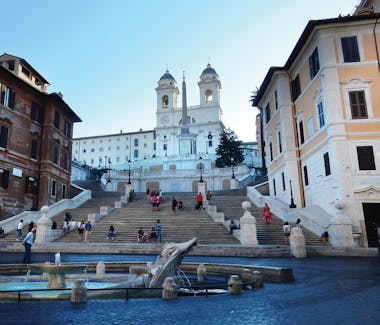
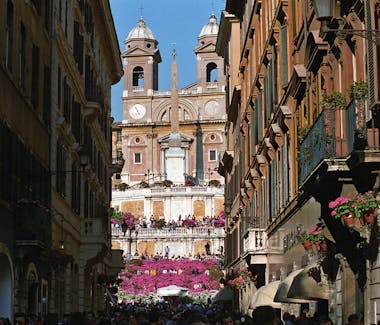
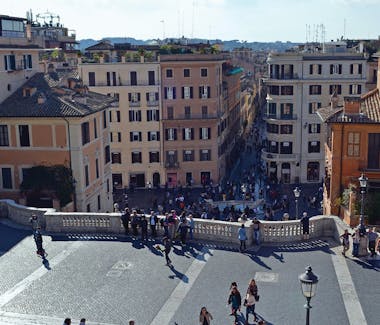
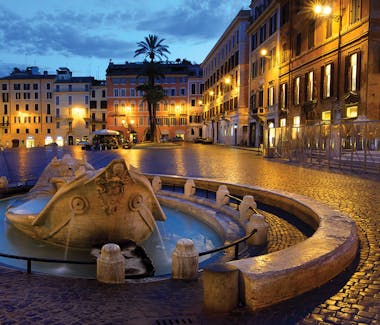
Piazza di Spagna, 00187 Roma RM
Piazza di Spagna
Piazza di Spagna, at the bottom of the Spanish Steps, is one of the most famous squares in Rome (Italy). It owes its name to the Palazzo di Spagna, seat of the Embassy of Spain among the Holy See. Nearby is the famed Column of the Immaculate Conception of the Blessed Virgin Mary.
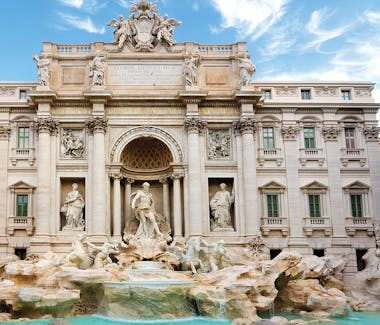



Piazza di Trevi, 00187 Roma RM
Trevi Fountain
The Trevi Fountain (Italian: Fontana di Trevi) is a fountain in the Trevi district in Rome, Italy, designed by Italian architect Nicola Salvi and completed by Pietro Bracci. Standing 26.3 metres (86 ft) high and 49.15 metres (161.3 ft) wide, it is the largest Baroque fountain in the city and one of the most famous fountains in the world. The fountain has appeared in several notable films, including Federico Fellini's La Dolce Vita, the eponymous Three Coins in the Fountain, and The Lizzie McGuire Movie.




Viale Vaticano, 00165 Roma RM
Vatican Museums
The Vatican Museums (Italian: Musei Vaticani) are Christian and art museums located within the city boundaries of the Vatican City. They display works from the immense collection amassed by Popes throughout the centuries including some of the most renowned classical sculptures and most important masterpieces of Renaissance art in the world. The museums contain roughly 70,000 works, of which 20,000 are on display, and currently employ 640 people who work in 40 different administrative, scholarly, and restoration departments. Pope Julius II founded the museums in the early 16th century. The Sistine Chapel, with its ceiling decorated by Michelangelo and the Stanze di Raffaello decorated by Raphael, are on the visitor route through the Vatican Museums. In 2017, they were visited by 6 million people, which combined makes it the 4th most visited art museum in the world. There are 54 galleries, or sale, in total, with the Sistine Chapel, notably, being the very last sala within the Museum. It is one of the largest museums in the world.
Piazza del Campidoglio, 00186 Roma RM
Campidoglio
Lorem ipsum dolor sit amet, consectetur adipiscing elit. Cras in orci diam. Quisque malesuada sodales faucibus. Fusce aliquet tellus sit amet ullamcorper vehicula. Duis lacinia velit vitae molestie porttitor. Fusce interdum odio leo. Lorem ipsum dolor sit amet, consectetur adipiscing elit. Cras in orci diam malesuada sodales faucibus .
Piazza Campo de' Fiori, 00186 Roma RM
Campo de' Fiori
Campo de' Fiori is a rectangular square south of Piazza Navona in Rome, Italy, at the border between rione Parione and rione Regola. It is diagonally southeast of the Palazzo della Cancelleria and one block northeast of the Palazzo Farnese. Campo de' Fiori, translated literally from Italian, means "field of flowers". The name dates to the Middle Ages when the area was a meadow.

Piazza di S. Giovanni in Laterano, 4, 00184 Roma RM
Archbasilica of St. John Lateran
The Cathedral of the Most Holy Savior and of Saints John the Baptist and the Evangelist in the Lateran - also known as the Papal Archbasilica of St. John [in] Lateran, St. John Lateran, or the Lateran Basilica - is the cathedral church of Rome, Italy and therefore houses the cathedra, or ecclesiastical seat, of the Bishop of Rome (Pope). It is the oldest and highest ranking of the four papal major basilicas, giving it the unique title of "archbasilica". Because it is the oldest public church in the city of Rome, and houses the cathedra of the Roman bishop, it has the title of ecumenical mother church of the Catholic faithful.
Viale delle Terme di Caracalla, 00153 Roma RM
Baths of Caracalla
The Baths of Caracalla (Italian: Terme di Caracalla) in Rome, Italy, were the city's second largest Roman public baths, or thermae, likely built between AD 212 (or 211) and 216/217, during the reigns of emperors Septimius Severus and Caracalla.[2] They were in operation until the 530s and then fell into disuse and ruin.
Terrazza del Gianicolo, 00118 Roma RM
Janiculum
The Janiculum is a hill in western Rome, Italy. Although the second-tallest hill (the tallest being Monte Mario) in the contemporary city of Rome, the Janiculum does not figure among the proverbial Seven Hills of Rome, being west of the Tiber and outside the boundaries of the ancient city.

Viale Gabriele D'Annunzio, 00187 Roma RM
Pincian Hill
The Pincian Hill is a hill in the northeast quadrant of the historical center of Rome. The hill lies to the north of the Quirinal, overlooking the Campus Martius. It was outside the original boundaries of the ancient city of Rome, and was not one of the Seven hills of Rome, but it lies within the wall built by Roman Emperor Aurelian between 270 and 273.
Piazza del Quirinale, 00187 Roma RM
Palazzo del Quirinale
Lorem ipsum dolor sit amet, consectetur adipiscing elit. Cras in orci diam. Quisque malesuada sodales faucibus. Fusce aliquet tellus sit amet ullamcorper vehicula. Duis lacinia velit vitae molestie porttitor. Fusce interdum odio leo. Lorem ipsum dolor sit amet, consectetur adipiscing elit. Cras in orci diam malesuada sodales faucibus .
Via Sacra, 00186 Roma RM
Arco di Tito
Lorem ipsum dolor sit amet, consectetur adipiscing elit. Cras in orci diam. Quisque malesuada sodales faucibus. Fusce aliquet tellus sit amet ullamcorper vehicula. Duis lacinia velit vitae molestie porttitor. Fusce interdum odio leo. Lorem ipsum dolor sit amet, consectetur adipiscing elit. Cras in orci diam malesuada sodales faucibus .
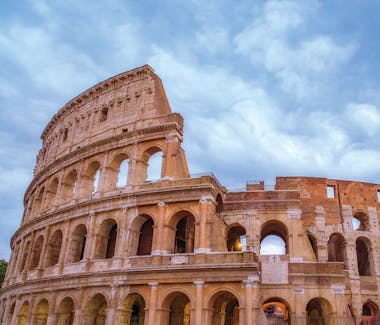


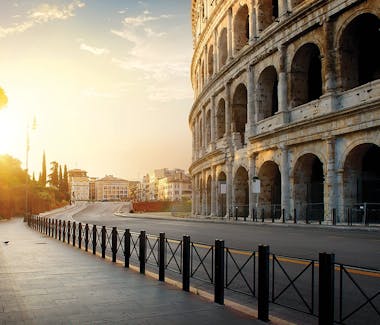
Piazza del Colosseo, 1, 00184 Roma RM
The Colosseum
The Colosseum or Coliseum, also known as the Flavian Amphitheatre, is an oval amphitheatre in the centre of the city of Rome, Italy. Built of travertine, tuff, and brick-faced concrete, it is the largest amphitheatre ever built. The Colosseum is situated just east of the Roman Forum. Construction began under the emperor Vespasian in AD 72, and was completed in AD 80 under his successor and heir Titus. Further modifications were made during the reign of Domitian (81���96). These three emperors are known as the Flavian dynasty, and the amphitheatre was named in Latin for its association with their family name (Flavius).
Via di San Gregorio, 00186 Roma RM
Arco di Costantino
Lorem ipsum dolor sit amet, consectetur adipiscing elit. Cras in orci diam. Quisque malesuada sodales faucibus. Fusce aliquet tellus sit amet ullamcorper vehicula. Duis lacinia velit vitae molestie porttitor. Fusce interdum odio leo. Lorem ipsum dolor sit amet, consectetur adipiscing elit. Cras in orci diam malesuada sodales faucibus .



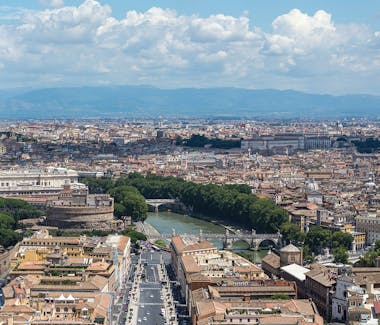

Lungotevere Castello, 50, 00193 Roma RM
Castle of the Holy Angel
The Mausoleum of Hadrian, usually known as Castel Sant'Angelo, is a towering cylindrical building in Parco Adriano, Rome, Italy. It was initially commissioned by the Roman Emperor Hadrian as a mausoleum for himself and his family. The building was later used by the popes as a fortress and castle, and is now a museum. The structure was once the tallest building in Rome.



Isola Tiberina 00186 Roma RM
Tiber Island
The Tiber Island (Italian: Isola Tiberina) is the only island in the part of the Tiber river which runs through Rome. Tiber Island is located in the southern bend of the Tiber.




Piazza San Pietro, 00120 Citt������ del Vaticano
The Papal Basilica of St. Peter in the Vatican
The Papal Basilica of St. Peter in the Vatican, or simply St. Peter's Basilica, is an Italian Renaissance church in Vatican City, the papal enclave within the city of Rome. Designed principally by Donato Bramante, Michelangelo, Carlo Maderno and Gian Lorenzo Bernini, St. Peter's is the most renowned work of Renaissance architecture and the largest church in the world.
